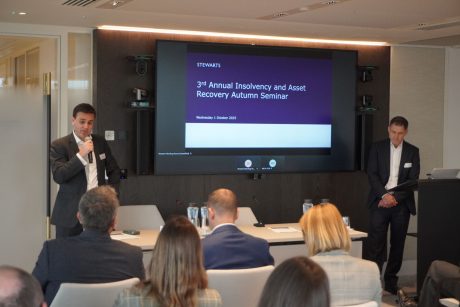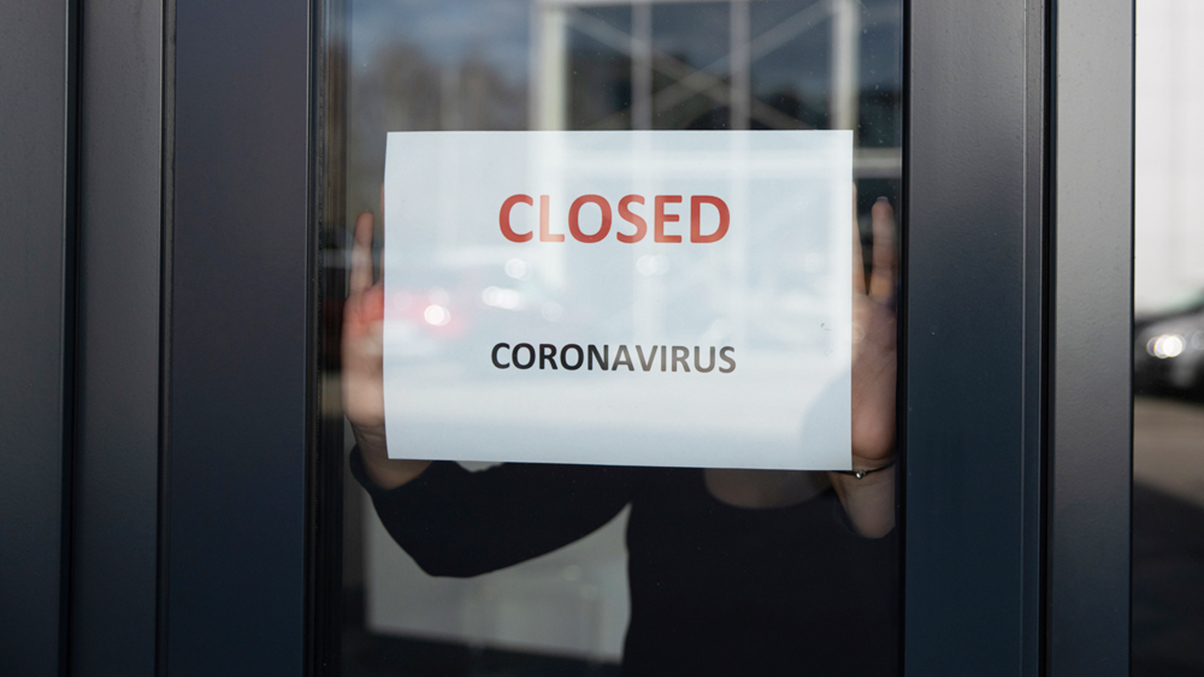On 1 October 2025, Stewarts hosted its Third Annual Insolvency and Asset Recovery Autumn Seminar, welcoming leading practitioners to share insights on the evolving legal landscape in insolvency, asset recovery, litigation funding, and trust disputes.
Key Takeaways
- Use statutory powers strategically: Sections 234–236 of the Insolvency Act 1986 are powerful tools for an insolvency practitioner, but requests made under these sections must be carefully considered and made with sufficient specificity.
- Prepare for funding reform: The CJC’s proposals, if implemented, will reshape litigation funding and both conditional and contingency fee arrangements.
- Leverage proprietary injunctions: These are now confirmed as viable in antecedent claims, even without current ownership.
- Navigate cross-border enforcement carefully: England remains a key jurisdiction, especially for crypto and digital assets.
- Scrutinise bank conduct: Quincecare claims are evolving, and banks must be alert to fraud indicators.
- Challenge trust structures effectively: Understanding control, jurisdiction, and legal remedies is essential.
Officeholder Powers: Sections 234–236 of the Insolvency Act 1986
Tim Symes and Astrid Gillam led this session which explored the statutory powers available to insolvency officeholders, focusing on how Sections 234–236 empower them to r cooperation from parties connected or who have had dealings with the company to obtain company property, documents and information concerning the insolvent company’s affairs
- Section 234 allows officeholders to recover specific property (e.g. assets such as plant machinery, computers or documents) from any person in possession or control of assets to which the company appears entitled. It does not apply to money claims or mortgaged property under which receivers were appointed before its administration or liquidation.
- Section 235 imposes a duty on on certain parties either previously connected with the company, including directors, managers and those who contracted with the company to cooperate with the officeholders.
- Section 236 enables courts to order individuals to appear before the court for examination, and to submit a witness evidence, or produce documents under their control. It applies broadly to anyone with relevant knowledge or possession of company property. s.236 continues to available after proceedings have been issued against a party being made subject to it depending on the stage of the proceedings.
Tim commented “Sections 234 to 236 give officeholders real teeth—but they must be used strategically. Courts expect specificity and justification, not fishing expeditions.”
Tim and Astrid also discussed how courts interpret the requirement that the officeholder “reasonably require” the information requested under ss.235 and 236 referencing the cases of Re Eversholt Rail and Re XL Communications Group, which emphasise the need for targeted and justified requests.
Funding and ATE Insurance: Regulatory Reform and Market Trends
In this session, Julian Chamberlayne addressed the seismic shifts in litigation funding proposed by the Civil Justice Council (CJC) report and the fallout from the PACCAR decision. The session also covered trends in the markets for litigation funding and ATE insurance, recent decisions on CFAs, DBAs and AAE, and related strategic considerations for insolvency practitioners. Key points included:-
- The CJC recommends urgent legislation to reverse the ongoing disruption to the market for litigation funding caused by the PACCAR, which classified percentage-based litigation funding agreements as (unenforceable) DBAs.
- The CJCs rejection of calls for caps on funders’ returns
- A new “light-touch” regulatory framework is proposed, to be regulated by the Lord Chancellor and supported by a Standing Committee of the CPRC. It includes:
- Case-specific capital adequacy
- Prohibition on funder control
- Mandatory disclosure and dispute resolution
- Unenforceability for breach unless “just and reasonable” to waive
- The CJC also advocates for a unified contingency fee regime, replacing the now settled CFA regulations and the much-criticised DBA Regulations, along with a shift to a success model for DBAs.
- The ground breaking Stewarts Litigate insurance facility including a sub-facility for Insolvency cases that can provide indemnities of up to £2m on a fully D&C basis.
Proprietary Injunctions in Antecedent Transactions
Alice Glendenning and Jack Barlow delivered a session focused on the landmark case Khan v Goldfarb [2025] EWHC 874 (Ch), which clarified the availability of proprietary injunctions in claims under s.339 and s.423 IA 1986.
- The court confirmed that a proprietary injunction can be granted even if the claimant does not yet have a proprietary interest, so long as the claim may result in one.
- This is particularly useful in long-running insolvency investigations where asset preservation is critical.
- Compared to freezing injunctions, proprietary injunctions are easier to obtain because there is no requirement to prove a risk of dissipation and delay is not an issue.
Alice and Jack also discussed implications for other antecedent claims under s.340, s.238, and s.239.
Alice commented “This decision confirms that proprietary injunctions are available in s.339 and s.423 claims even without a current proprietary interest. That’s a game-changer for asset preservation.”
Cross-Border Asset Recovery and Foreign Judgment Enforcement
Tom Clark explored how English courts support foreign proceedings and facilitate international asset recovery.
- Tools for evidence gathering include Evidence (Proceedings in Other Jurisdictions) Act 1975, and Cross-Border Insolvency Regulations 2006.
- England offers strategic advantages: fast procedures, sophisticated and respected rule of law, and receptiveness to crypto-related claims.
- Foreign judgment recognition under various regimes (e.g. Statutory, common law)
- Enforcement mechanisms including like freezing orders, charging orders, and bankruptcy petitions.
The session also covered the Dadourian Guidelines and recent developments in digital asset enforcement.
Tom concluded “English courts are increasingly receptive to supporting foreign proceedings, especially in crypto and digital asset cases. But careful strategic and jurisdictional analysis are essential.”
Debt and Negligence Claims Against Banks
Alex Jay and Harry Spendlove discussed the Quincecare duty. Their session reviewed recent high-value claims against banks, including the implications of Philipp v Barclays. Key issues include identifying unauthorised payments and gathering evidence of fraud through account activity and internal knowledge.
- The Supreme Court clarified that banks must act within their mandate and cannot rely on apparent authority if they are on notice of fraud.
- Claims under the Quincecare duty hinge on whether, and when, the bank was on notice and should have made inquiries.
- The speakers shared examples of cases they have worked on, and litigation and settlement strategies.
Harry and Alex previously delivered a podcast about this topic which can be listened to here.
Trusts: 5 Things You Need to Know
Marcus Parker offered practical guidance on trusts when they are encountered by practitioners in an insolvency context. The session emphasised that a number of questions need to be considered to determine how trusts can be attacked.
- Is it even a trust? – trusts are more capable of attack if they are a sham or “illusory” or there is excessive settlor control.
- Does jurisdiction matter? – the ability to attack differs considerably between jurisdictions and much turns on reputation, the availability of quality professionals and the efficiency and robustness of local Courts.
- Does choice of trustee matter? – the ability to attack may be affected by the size and role of the trustee and private trust companies may make a big difference.
- Do protectors matter? – they may be relevant and their role and the scope of their powers should be investigated.
- Powers to attack – specific powers and how they are exercised can be challenged and receivers can be appointed over a power to revoke.
Marcus’ key take away from the session is “trust structures are not impenetrable and free from challenge. Knowing what to look for and asking the right questions is key.”
Conclusion
This year’s seminar showcased Stewarts’ thought leadership across insolvency and asset recovery. From proprietary injunctions to funding reform and cross-border enforcement, the sessions provided actionable insights for practitioners navigating complex legal terrain.
For more information or to access the full seminar materials, please contact the Insolvency and Asset Recovery team at Stewarts.
To register for updates from the Insolvency and Asset Recovery team, please click here.






